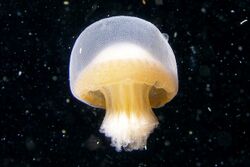Biology:Ptychophorae
From HandWiki
Short description: Suborder of jellyfishes
| Ptychophorae | |
|---|---|

| |
| Scientific classification | |
| Domain: | Eukaryota |
| Kingdom: | Animalia |
| Phylum: | Cnidaria |
| Class: | Scyphozoa |
| Order: | Rhizostomeae |
| Suborder: | Ptychophorae Gershwin & Davie, 2013 |
Ptychophorae is a suborder of rhizostome jellyfish, identified in 2013 by Gershwin and Davie.[1]
The word Ptychophorae is said to be derived from the Greek Script error: The function "transl" does not exist. (fold, leaf, layer) and Script error: The function "transl" does not exist. (bearing), in reference to the hooded rhopalia.[1] The proper word for 'fold' in ancient Greek is however ptyx (πτύξ).[2]
Distinctive features
Ptychophorae are distinguished by the following features:
- The body is globular.
- The oral arms coalesce into a single short, ridged column, without scapulets.
- The rhopalia is hooded, lacking typical pits.
- There are 4 velar lappets per octant.
- There 2 asymmetrical ocular lappets per octant.
- The annular muscles are conspicuous.
- The subgenital ostia are very small and round.
- The stomach is circular and large.
- There are 4 radial canals per octant, proximally unbranched, and fluted, and peripherally coalesced into vast open sinus with patchwork of jelly matrix.
Taxonomy
- Family Bazingidae
- Genus Bazinga
The single identified member of this suborder is the Bazinga rieki.
References
- ↑ 1.0 1.1 "A remarkable new jellyfish (Cnidaria: Scyphozoa) from coastal Australia, representing a new suborder within the Rhizostomeae. Memoirs of the Queensland Museum — Nature 56(2)". Queensland Museum. 30 June 2013. pp. 625–630.. http://www.qm.qld.gov.au/~/media/Documents/QM/About%20Us/Publications/Memoirs%20-%20Nature/N56-2/qmn56-2-gershwin-davie.pdf.
- ↑ Liddell, H.G. & Scott, R. (1940). A Greek-English Lexicon revised and augmented throughout by Sir Henry Stuart Jones with the assistance of. Roderick McKenzie. Oxford: Clarendon Press.
Wikidata ☰ Q16757967 entry
 |

